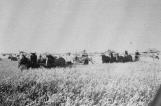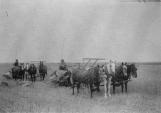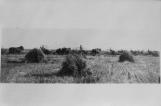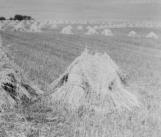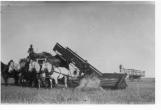2
Binders were the first implement used at harvest time. Sickle blades cut the stems of the plant and laid them on a conveyer where they were gathered together and tied with twine. This was a manageable bundle called a sheaf.4
A team of horses pulled the binder. One of the wheels provided the power to drive the cutting and binding mechanisms.6
HarvestingWheat and oats were harvested in the early fall, in August. Generally, we could figure harvest would be over by August 23rd. Sometimes we would get a light snow and having a freeze at night by that date. A man who owned a threshing machine would contract with the various farmers around. He would furnish the machine and full to run it, and would furnish a mechanic and do all repairs. The farmers would furnish all the rest of the labor, horses, bundles wagons, pitchforks, etc. The farmers would pick up the bundles of wheat, where the wheat had previously been "stooked" (4 bundles cut and tied by a binder were set up like the farmers did here, only the farmers here would have 12 - 14 bundles in one stack) and thrown onto a bundle wagon. When filled it was driven to the threshing machine and thrown, a bundle at a time, into the machine. Another neighbor or the farm owner would then haul the threshed grain to the farmers elevator or directly to the elevator in town. All the neighboring farmers contracting with the thresher participated in this labor. The farm on which you were threshing was responsible for feeding everyone, but the wives also participated in the cooking and serving.
8
StooksAfter the binder made the sheaves, women and children stood a few sheaves up, leaning them against each other. The resulting "stook" shed rain and snow and kept the heads of the plant up in the drying winds. When the seeds in the head were dry enough to store, the sheaves were loaded into wagons and taken to the threshing machine.
10
HarvestingThis was always a hot time of year. A lot of grains were cut with a binder and we had to stook the sheaves--stand about 8 together so the grain would dry on top. When it was time to thresh them, the neighbours would come with their teams and hay racks, load up the sheaves, by hand usually but Dad did have a stook loader. The racks were driven up alongside the threshing machine (sometimes the horses objected when they got near the 100' or so belt moving beside them. This ran from the tractor on a pulley to the thresher and drove the mechanism. There was always a big straw pile in the yard or field and sometimes they blew the straw right into the loft as they threshed. They always stopped on time for meals and for lunches morning and afternoon as the horses needed a rest too. We always enjoyed the lunches of hot biscuits and tea in a 2 quart sealer, usually with lots of cream and sugar in it. If we were lucky we got to sample what was left. When combining, the grain was usually hauled with horses hitched to a grain wagon but later a truck was used. I used to help Dad unload the wagons or truck into the grain auger which elevated it into the granary. There was always some shovelling to do to empty out the wagon or truck and to pick up what was spilled around the auger. Before I had my drivers license, I was hauling grain from the field and at times hauled right to the elevator in town. This was great! The hayflats grew mainly hay which was cut, raked in piles and hauled home to be put in the loft for winter. I remember the old cook car which stayed most of the time in the flats, for the men to eat and sometimes sleep in. It was like a playhouse with table and chairs, dishes, stove, etc. Coffee was made in a big pot and the dishes were blue & white enamel. This house on wheels was 4 or 5 ' off the ground so there was a stairway up to the platform. We kids were putting in time up there one day when we got a hold of some matches and started a bonfire. Well that dry hay just took off and luckily the men weren't too far away and got it out before too much damage was done but we were sure scared and got a good lecture over that. No more playing with matches.
12
A Stook LoaderA labour saving device called a stook loader was faster and easier than loading the wagons by pitchfork. The horse-drawn, ground-driven machine picked up a stook (a few sheaves) which was elevated by a wide conveyer system. The sheaves were dropped into the hay wagon, being pulled alongside, and transported to the thresher.
